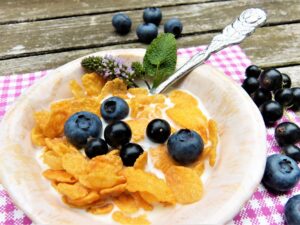The Food & Drug Administration (FDA) recently proposed updating the definition of “healthy” for the purposes of food labeling, to align it more with the 2020-2025 US Dietary Guidelines for Americans (DGA).
This may be my most challenging post to date, because the proposal give me very mixed feelings, both pro, and con.
Why Update Now?
Nutrition science constantly evolves. We know more now. The current “healthy” term, in place since 1994, sets limits on total fat, saturated fat, cholesterol and sodium. A food labeled “healthy” must also have at least 10% of the Daily Value (DV) for at least one of these nutrients: vitamin A, vitamin C, calcium, iron, protein and fiber.” The goal of the label: to “help consumers maintain healthy dietary practices.”
Plus, the current definition disqualifies some terrific foods, like salmon and almonds, due to their fat content, even though the type of fat they have is good for us. The new rule focuses on limiting saturated fat, not total fat. More on that later.
The proposed rule would also severely limits refined grains and added sugars, which the present rule doesn’t.
“Healthy 2.0” Foods: What’s In, What’s Out

Photo by Abstral Official on Unsplash
The DGAs recommends the maximum “Daily Value” of sugar and saturated fat we should consume is “less than 10% of the total calories” per day. For sodium it’s 2,300 milligrams/day, using a 2,000 calorie diet as the reference.
The “healthy 2.0” label would put that “10% limit” on individual foods, not an overall diet.
The result? A serving of food labelled “healthy” has a MAXIMUM of:
- 2½ grams of added sugar, about ½ teaspoon.
- 2 grams of saturated fat, LESS than half a teaspoon.
- 230 mg. of sodium – LESS than the amount in 1/8 teaspoon of salt – a small pinch.
All whole fruits and veggies are fine, as are nuts and seeds, avocados, and most fish and liquid oils.

Photo by Aliona Gumeniuk on Unsplash
What COULDN’T be labeled “healthy”:
- All cheeses except fat-free cheese.
- All full-fat dairy foods, including milk, yogurt, cheese.
- Any yogurt with more than 2.5 grams of added sugar (that’s most sweetened yogurt, Greek or regular).
- All breads and cereals that aren’t at least ¾ whole grain AND have less than that 2½ grams of added sugar.
- White rice, regular pasta.
Why This Proposal Has Me Boiling

Photo by Andre Hunter on Unsplash
These requirements are too heavy a lift for a single word. “Healthy” is even the wrong word, according to Connie Diekman, registered dietitian-nutritionist and former president of the Academy of Nutrition and Dietetics. “Food cannot be healthy but it is healthful as it nourishes our body!” she explained. “Foods can be packed with lots of nutrition but until we consume them they can’t provide any health benefits,” she said. It’s more about their potential, “thus they are full of health or healthful!”
Per Diekman’s explanation, many foods that are healthful in the context of your total diet, WOULDN’T be labeled “healthy”.
My concerns:
- The proposal’s lack of “total diet” context kills its usefulness and unfairly demonizes many foods that can and, arguably, should, be part of a balanced, healthful dietary pattern. The DGAs focus on a healthful “eating style”, not individual foods. This FDA proposal is more likely to confuse consumers than educated them.
- Excluding foods like full or reduced-fat milk, yogurt, and cheese, all great sources of 3 of the 4 “nutrients of concern”(calcium, potassium, and vitamin D) that the DGAs call out as lacking in most diets, could not be labeled “healthy”.
- I get the concern about saturated fat, but increasingly, studies suggest that saturated fat bound to protein, as in yogurt, cheese, and milk (vs. butter, which has no protein), may LOWER risk for cardiovascular disease and diabetes.
- Refined staple grains, like rice, or cereals like corn flakes have a place in a healthy diet. They’re eaten as part of a meal and are “vehicles” for delivering fruits, vegetables, beans, and fish and milk – all needed in a balanced diet.
- The dilemma, and it’s real: if there’s no “healthy” label definition, anything could qualify. That doesn’t help consumers either.
“Healthy” Is A SPECTRUM, Not An Absolute
People tend to like definite, clear concrete labels and boundaries, but food doesn’t work like that and neither does health.
A “healthy foods spectrum” considers:
- Portion size
- Frequency of consumption
- Context: what else your diet includes
Indeed, overall balance and context are everything. Concrete examples:

Photo: https://pixabay.com/photos/corn-flakes-milk-berry-blueberries-2546097/
- You’re happy with fat-free Greek yogurt and low-fat (1%) milk. But you also like real cheese. An ounce a few times a week still works in a healthful diet.
- A diet of only spinach and almonds would contain only “healthy” foods. It would also be unbalanced.
- Corn flakes with low-fat milk and sliced fruit delivers two under-consumed food groups – low-fat dairy and fruit, and it’s A-OK.
- Even indulgence has a spectrum: An ounce of dark chocolate won’t have a “healthy” label, but it’ll have far less sugar and calories than a slice of cake, so it may be a BETTER choice.
Cut-To-The-Chase Takeaways
- Hold any obsession on every food having a “healthy” label. Instead, focus on how much, how often and what else you’re eating!
- An “overall healthy diet” gets it right: a balance between foods we know we need and foods we don’t want to live without.
Featured photo: Zachary Kadolph on Unsplash






